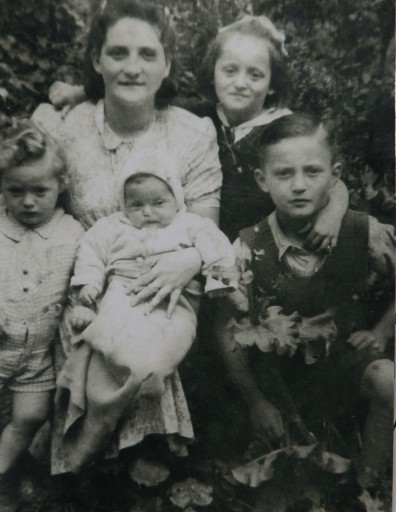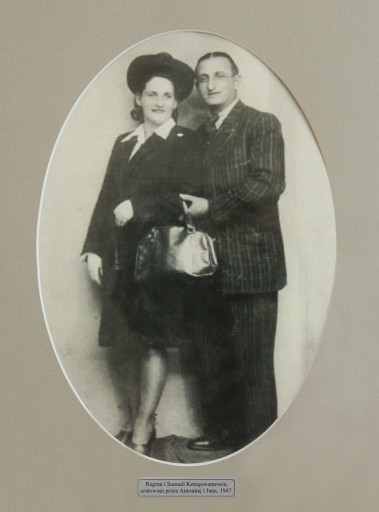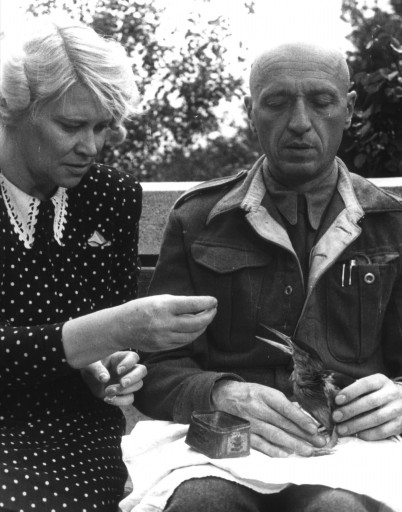 Warsaw, Poland – The young boy emerged from the rubble of Warsaw, clinging to the skirt of a woman he knew only as Mrs. Wala. Then she turned and walked off, and 7-year-old Mieczyslaw Kenigswein was alone, lost in the Holocaust. It was 1944.
Warsaw, Poland – The young boy emerged from the rubble of Warsaw, clinging to the skirt of a woman he knew only as Mrs. Wala. Then she turned and walked off, and 7-year-old Mieczyslaw Kenigswein was alone, lost in the Holocaust. It was 1944.
Subscribe to our Daily Roundup Email
That little boy is now 78, an Israeli with a Hebrew name, Moshe Tirosh. During a recent visit to Warsaw, he recalled surviving the rest of the war not knowing if his parents were dead or alive — and how the kindness of strangers and random turns of fate saved his life.
Tirosh’s earliest memories are of the hunger, disease and misery of the Warsaw Ghetto.
Affectionately called Miecio as a boy, he was nearly 5 when his mother, Regina, gave birth to her third child under floorboards in the ghetto, biting her knuckles to keep from screaming during labor so the Germans would not discover the newborn.
With death all around, Tirosh said his parents made the excruciating decision to part with the infant to increase his chances of survival.
With the help of a young Pole, Zygmunt Pietak, his mother smuggled the newborn out of the ghetto and left him on a street corner with a card bearing the name “Stanislaw Pomorski” — a fake surname meant to hide his Jewish origins.
Soon a Polish policeman came along and took the baby to a home for abandoned children.
The next year was 1943, and Tirosh’s father, Samuel, was helping other Jews plan the uprising in the ghetto when he decided to try to flee with his family.
“He was told there was no way to escape,” Tirosh recalled. But his father was determined.
Now 6, Miecio and his 4-year-old sister, Stefania, were packed in rag-padded sacks and thrown over the high ghetto walls. The parents climbed over themselves, bribing Polish guards to turn the other way.
They first found shelter with a Polish family, the Raczeks, who took them in for money. There, the family would go into hiding behind the apartment walls or in closets during inspections by Germans or visits by the Raczeks’ friends or neighbors. The danger of being betrayed to the Nazis was high and the punishment for helping Jews was severe: death to any rescuer and their entire family.
Terrified, Mrs. Raczek decided after a few months she could no longer bear the risk.
Pietak stepped in again, this time to smuggle the Kenigsweins to the Warsaw zoo, where the zoo director and his wife, Jan and Antonina Zabinski, had been sheltering Jews.
It was a cold and rainy night in late 1943 when the family climbed into a horse-driven carriage for the trip to Warsaw’s Praga district, a perilous journey over the Vistula River past German guards on both sides of a bridge.
Pietak sat next to the driver. When they approached the Nazi guards, he pulled out a bottle of moonshine and splashed the horses and himself with it.
“Halt!” the Germans ordered. When they smelled the alcohol, they shouted, “Polnische Schweine, Weg!” — “Polish pigs, go away!”
“And that’s how we got though,” Tirosh recalled. “It was the same at the second crossing and we made our way to the zoo.”
By this time, most of the zoo animals had been killed or hauled off to zoos in Germany, and Zabinski had turned it into a pig farm.
Miecio and Stefania stayed in a basement for a few weeks while their parents hid out of sight in animal cages.
It was traumatic for the little girl, who often cried for her mother. Aware of the danger, Miecio covered her mouth to stifle her sobs.
The Zabinskis could not keep them indefinitely and, one day, the zookeeper’s wife brought Miecio upstairs and tried to dye his dark hair blond, hoping to make him look more “Aryan.” Instead, it came out red, earning him the nickname “Squirrel.”
Again with the help of Pietak, the family found new shelter in the tiny apartment of a captain in Poland’s underground army, Feliks Cywinski. Cywinski created a hiding place by pulling bricks out of the thick outer walls. But that couldn’t serve for long — the necessity of buying so much food for such a small household was certain to arouse suspicion.

So it was decided that splitting up the family would increase their chances of survival.
A childless shopkeeper agreed to adopt Stefania but it was more difficult to hide Jewish boys, who, because they were circumcised, were at risk of being uncovered as Jews.
Eventually, Pietak found a place for Miecio with a woman he remembers only as Mrs. Wala. She had a daughter about his age and agreed to take him in for money.
“I didn’t want to go, but my father explained I would be safer with her,” he said.
During the bombardment of 1944, the merciless German response to the Warsaw uprising, sirens signaled for people to take shelter and Miecio ran into a cellar with Mrs. Wala and her daughter.
The bombing caused the four-story building above them to collapse. Men in the cellar used poles to knock a way out.
The survivors emerged to an apocalyptic scene of destruction.
“The street wasn’t a street but a mass of rubble,” Tirosh recalled.

“In one hand, Mrs. Wala held a suitcase and, in the other, her little daughter’s hand. I held onto her skirt and we ran,” he said.
“At one point, we stopped and I lost hold of her. And I remember this exactly to this day: She turned to me and made an expression that said she was very sorry that she was leaving me, and then she walked away with her daughter.”
“I was left alone in the rubble,” he said.
With Germans shooting Poles in the area, Miecio pressed his hands together and kept repeating “Jesus, where is my aunt?” It was something Mrs. Wala had taught him to do should he ever be caught alone, in an attempt to appear Catholic.
Two Polish underground fighters spotted him and pulled him into shelter.
“This must be a little Jew,” one said. They gave him a card saying he was an orphan and sent him on. With the help of another stranger, he made his way to a church-run orphanage.

Soon, the orphans were evacuated to southern Poland, where Miecio lived out the rest of the war in a monastery in Stankowo, near Krakow.
“And there I endured hell,” he said, describing hunger, illness, flea infestations and beatings by older boys who discovered he was Jewish after pulling his pants down during a bath.
The children subsisted on turnips and water, and whatever potato scraps they could steal from a nearby pigsty run by Germans. Disease was rife; every day, nuns carted away the corpses of children who had succumbed.
But Miecio enjoyed the protection of a priest, Father Andrzej, who gave him a little of his own soup and ordered the other boys not to hurt him.
“It’s a matter of our Polish honor that this child survives the war,” the priest told the boys. The beatings became fewer, but did not stop altogether.
Then, on New Year’s Eve in 1944, just weeks before the arrival of the Soviet army ended the Nazi occupation, a Polish farmer and his wife came to the orphanage to adopt a boy. With the children lined up, the couple went one by one, looking into their eyes. Lifting Miecio’s chin, the wife turned to the priest and said, “Father, we want this one.”
“No, you don’t,” Father Andrzej said. “He is weak, and always sick. Please choose another one.”
But the couple insisted, and Miecio was taken by sled through the snow to the farmers’ home.
That night, the farmer’s wife bathed him. Despite his efforts to hide his private parts, she made the inevitable discovery of his circumcision. She then put him in a warm bed and spent the night sewing new clothes for him.
The next morning, the farmer returned Miecio to the orphanage.
Today, he is grateful the couple didn’t keep him. Had he stayed on that isolated farm, he thinks, he might never have been found by his mother after the war.
With 6 million Jews dead and most survivors bereft of loved ones, the Kenigsweins were lucky: Both parents and their three children survived and, with painstaking effort, Regina Kenigswein eventually tracked down her children.
The woman who had adopted Stefania did not want to give her up but was persuaded when offered enough money.
The youngest, Stanislaw, was a sick and underdeveloped 3½-year-old. He had been evacuated with other foundlings to the southern Polish city of Czestochowa, where his mother found him.
She found Miecio 10 months later in a church-run orphanage in Krakow, where he was taken after the war. At first he, didn’t recognize her. And the orphanage director, not knowing he was Jewish, didn’t want to give him up.
“How can he be yours if you are Jewish and he is a Pole?” the director asked.
The boy was told to pull down his pants, his circumcision once again the proof of his Jewish heritage.
After the war, Samuel Kenigswein made a fortune manufacturing shoe polish and in other enterprises, and two more children were born — Rachel, in 1946, and Arie, two years later. Then the family’s luck ended: Samuel Kenigswein’s heart gave out in 1948, soon after his fifth child was born.
In 1957, the rest of the family immigrated to Israel. There, Tirosh became an army officer and married an Israeli woman. Today, he speaks with joy of his three children, six grandchildren and an extended family of 56. He doesn’t say it, but it is understood: 56 people who could just as easily not have been here.


Thank you for this wonderful tale of survival. If only we could of many more like this. But, alas, there aren’t many more.